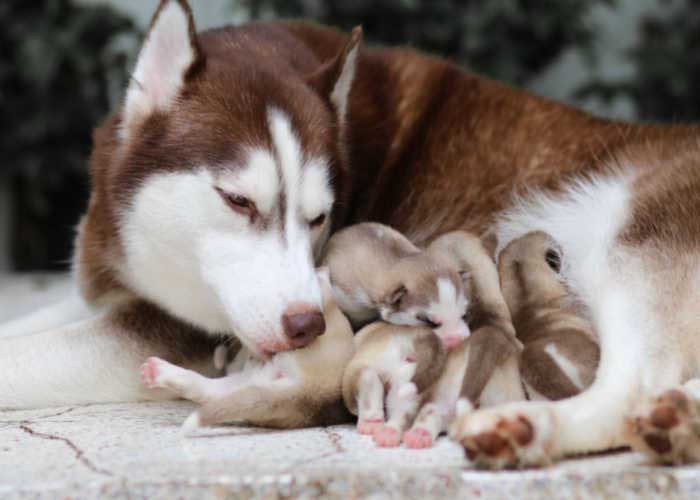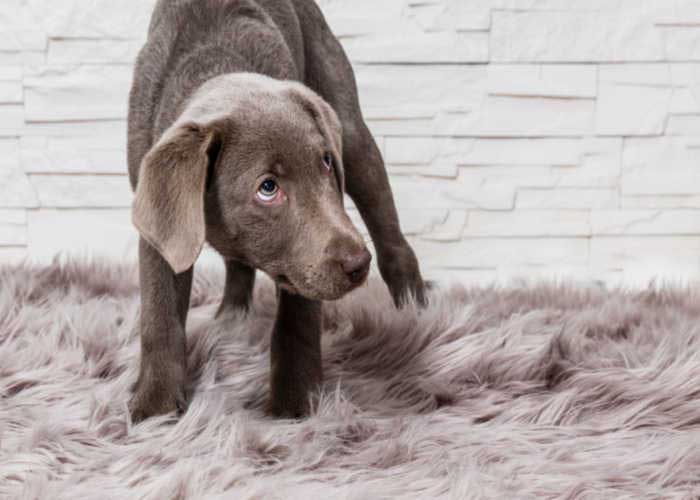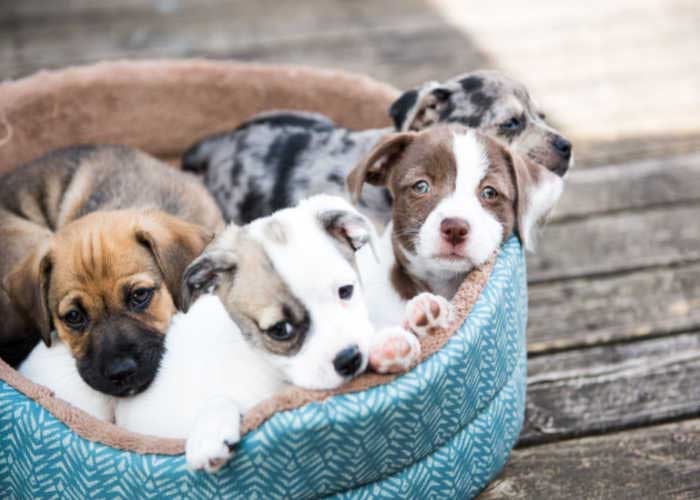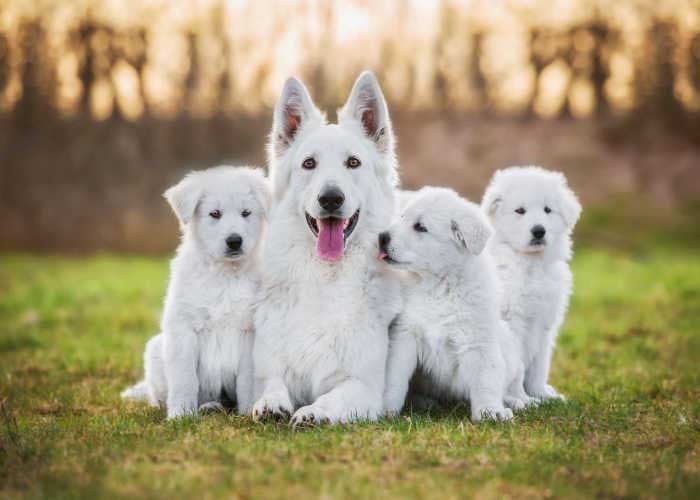Table of Contents
The same with a human child, a puppy is heavily dependent on its mom. So, why do we do a dog litter separation?
A typical litter can range from 1 to 12 puppies, with 5 to 6 pups as the average size across all dogs. During the first few weeks, they get the love and food from their mother.
As tempting as it is to become fur parents, the puppy needs to be with its biological mom together with its brothers and sisters at this point. This crucial period will affect your fur baby’s behavior later in life.
Once ready, you will have to separate your fluffball from its littermates.
This leads us to the question: how do you split a litter of puppies when it's time to say goodbye?
Today, we are getting the facts about separating dog siblings and how the mother dog copes with it.
What is Dog Litter Separation?
Dog litter separation happens when puppies are separated between the ages of 8 to 12 weeks old.
Yes. You read it right. Mother dogs don’t get to keep all of their babies.
It may be heartbreaking, but a puppy needs to gain independence to grow into one healthy, well-behaved adult. Veterinarians agree that it is best to split a litter of puppies for each of them to develop as an individual.
If they live together into adulthood, they become highly reliant on one another. This will make the separation difficult as the dogs exhibit extreme anxiety.
As a result, they will fail to bond with their human family. So, whenever owners have dogs with litter, they usually give them out to family and friends.
However, this does not mean we can split them right after they are born. There is a proper period to follow from when the mother dog gives birth to the day the puppies are old enough to leave their mom.
In the early days of its life, the puppy learns social skills from its mommy and siblings. This socialization period lasts from six to twelve weeks.
Some split a litter of puppies as these dogs reach six to eight weeks of age, but most breeders wait until ten to twelve weeks.
What is the Effect of Early Dog Litter Separation?
Separating littermates at the right time can ensure a smooth transition as the puppies move on to their new homes. Experts advise that a pup should not be separated from its mother until at least 8 weeks old.
If done too soon, there are potential consequences to happen.
To begin with, the puppy may suffer from stress and anxiety that can hinder its adjustment once someone takes over the role as a parent.
Excessive barking, fearfulness, hypersensitivity to noise, and attention-seeking behavior can be distressing to new owners.
In addition, if the puppy did not learn bite inhibition with the siblings, it might unintentionally hurt its playmates while goofing around.
When it comes to training, it may be hard to do so since they have not experienced being disciplined by their mom. This may lead to behavioral problems.
The pup may have decreased learning ability and poor physical condition. It may also be prone to diseases from a lack of mother’s milk.
Not only will the puppy suffer, but abrupt weaning will cause congestion in the mother dog’s mammary glands leading to inflammation.
There is also the risk of the mother getting depressed when the puppies leave below 8 weeks.
Why Wait for Eight Weeks for Dog Litter Separation?
Puppy litter separation is inevitable. But before that happens, these adorable balls of fluff need to grow up along with their littermates for several reasons.
Aside from love and protection, puppies depend on their mom for food even though it means fighting with siblings for milk. But isn’t that what siblings are for?
In addition, the puppy learns social skills by playing with its siblings. They influence one another’s mental health and well-being, as well as, protect each other from loneliness and depression.
This connection roots deeply in their development as they are nurtured until ready to come out into the world. Puppies learn how to communicate with canines through play.
They also learn the need to control their bite. When a puppy bites too hard on its sibling, the other will cry or yelp, leading to withdrawal from play.
So, this teaches them to control the force of their mouthing.
In conclusion, this bond instills basic canine manners. Mothers discipline these fur babies whenever they behave differently by growling or snapping at them.
RELATED: U.S. Statistics on Dog Bites 2021
How Do You Handle Dog Litter Separation?
During the first 2 weeks, limit your interaction with the litter since newborn puppies are fragile to excessively handle. As long as they are healthy and gaining weight, the puppies are doing just fine.
Avoid disturbing the litter unnecessarily as it may stress out the mother. Keep the whelping area calm to prevent the mother from getting aggressive.
With maternal aggression, you may manage it with her favorite treats to remind her that you mean well. If the protective mother still won’t calm down, simply give her space.
Most of the time, the mother leaves the litter to stretch and eat. You may also lead her away from the litter for regular potty breaks.
After 2 weeks, she will start leaving the puppies alone to encourage independence. The puppies will start to crawl or walk to explore their surroundings.
At this stage, you may set up a separate bed for the mother since she still wants to stay nearby. Give her a restful spot where she can keep an eye on the litter.
Before Splitting a Litter of Puppies
At 3 to 4 weeks old, start weaning the puppies.
When the puppies are nearby, let them observe their mother while she is eating. From their mother’s milk, introduce a solid growth diet of puppyhood.
Start by offering 1 meal of wet food per day to wean them gradually.
Encourage the mother to leave the litter during meal times so that they’ll eat instead of breastfeeding. Reduce the mother’s frequency of nursing her puppies.
This is also the stage wherein you can hold the puppies daily to get them used to human touch. Help them get acquainted with being handled.
At 5 to 6 weeks old, offer more solid food by feeding them blended formula and dry food. Each week, reduce the amount of liquid you add so the food becomes thicker and chunkier.
Expose the puppies to their environment. They will be active and curious, so let them explore new surfaces and give them toys with interesting shapes and sizes.
Allow the puppies to meet and interact with well-behaved animals to become their furry friends. Make the situation and experience positive.
By 8 weeks, feed the puppies dry puppy food. This will also be the stage when the puppies are ready for their new family if you are rehoming them.
During the Separation
The maternal instincts of their mom start to go away as the litter matures. So, she will also be ready for the puppies to leave.
8 to 10 weeks are the appropriate age for the puppy to thrive on his own. If you are rehoming them, find good homes for your litter of puppies.
Many people want to buy or adopt puppies. Just make sure they know what they are dealing with to prevent your puppies from being abandoned in shelters or worse, in puppy mills.
Allow potential adopters to visit the puppies. Separate the chosen pup from the littermates for an hour daily.
This is the time that they increase their contact with people.
Since the puppies are old enough, let them play with their potential new owners. This will distract the puppies and help the new bond.
After Splitting a Litter of Puppies
Although puppies are highly adaptable, soothe the poor fluffball after separating it.
Give the new family a towel or other objects with familiar scents and pheromones to help them adjust. Having a familiar object helps the fur baby to be comfortable with the new environment.
It is natural for a pup to cry or whine at first. Some may have difficulty falling asleep and get easily frightened leading to restlessness.
But most adjust to a new home within just a couple of days. The social skills they developed with their littermates should ensure they can properly adjust to being out in the world.
A calm and quiet new home will help the pup settle in. The new owners must make adjustments to accommodate their new furry friends, such as encouraging socialization and offering lots of quality playtime.
By doing so, they are reassuring the puppy that it has not been abandoned but rather given a new home with the undivided attention and love it deserves.
Is it Ideal to Raise Littermates?
Experts don’t recommend adopting puppies from the same litter as they become inseparable.
As you adopt two puppies, for example, they may refuse to interact with others since their bond as siblings will be enough. Worse, these dogs may not feel the need to connect with their human family.
This can make teaching commands challenging. Neither of them will be trained to high reliability.
So, in terms of training and making the new family members more tolerable, it will be twice the work, cost, and effort on your part as their handler.
Although it rarely happens to rehome a pair together, many shelters will advise against it.
As these puppies mature, there might be a sibling rivalry. There are pet owners who can’t even walk one without the other.
Raising a puppy is already challenging. Having two will be downright overwhelming.
Unless you have a significant amount of time and commitment to raising each with individual training, exercise, and socialization, then you can’t take on two pups.
If you are up to the challenge and choose to adopt two puppies at the same, it’s best to adjust your care.
By giving individual attention, separate crate training, playtime with other dogs, and individual walks, you can raise littermates efficiently and effectively.
FAQs about Dog Litter Separation
Should you do the dog litter separation?
Splitting a litter of puppies will teach them to be independent. Pet behaviorists even suggest separating dog siblings than keeping them together.
It may be a stressful process, but the adjustment period can run smoothly with love and support.
Is dog litter separation cruel to do?
If done properly and at the right time, separating the puppies from their mother is not cruel. In fact, moms get to rest and feel relieved when puppies are removed at the right age.
Even if you don’t separate them, the mother dog eventually leaves the puppies to get some peace in her own space.
How do you separate a mother dog from her puppies?
The weaning process begins by separating the puppies from their mother for a few hours at a time. While separated, introduce the pups to eating from a pan.
This lessens the puppies' dependence on their mother's milk and presence.
Dog Litter Separation Final Thoughts
Since humans miss the people close to them, you may probably think that puppies feel the same with their littermates.
So, do puppies miss their siblings?
It cannot be determined if a puppy feels sad when we do dog litter separation. However, what we do know is that it feels stress and anxiety as it faces a huge change in its life.
The puppy may have a tough time adjusting when separated as it may feel alone. With comfort and care, any sign you see that it is sad from being separated soon fades.
Playtime also distracts this fur baby while providing mental and physical stimulation. Continue to socialize with the little pup and provide positive experiences for it to grow up as a well-rounded pooch.
As fur parents, it will be our responsibility to provide a safe, welcoming, and fun environment for our dear canine companions. By making them feel loved, surely your fur baby will settle down quickly.




















